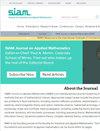Cover Times of Many Diffusive or Subdiffusive Searchers
IF 2.1
4区 数学
Q1 MATHEMATICS, APPLIED
引用次数: 0
Abstract
SIAM Journal on Applied Mathematics, Volume 84, Issue 2, Page 602-620, April 2024.Abstract. Cover times measure the speed of exhaustive searches which require the exploration of an entire spatial region(s). Applications include the immune system hunting pathogens, animals collecting food, robotic demining or cleaning, and computer search algorithms. Mathematically, a cover time is the first time a random searcher(s) comes within a specified “detection radius” of every point in the target region (often the entire spatial domain). Due to their many applications and their fundamental probabilistic importance, cover times have been extensively studied in the physics and probability literatures. This prior work has generally studied cover times of a single searcher with a vanishing detection radius or a large target region. This prior work has further claimed that cover times for multiple searchers can be estimated by a simple rescaling of the cover time of a single searcher. In this paper, we study cover times of many diffusive or subdiffusive searchers and show that prior estimates break down as the number of searchers grows. We prove a rather universal formula for all the moments of such cover times in the many searcher limit that depends only on (i) the searcher’s characteristic (sub)diffusivity and (ii) a certain geodesic distance between the searcher starting location(s) and the farthest point in the target. This formula is otherwise independent of the detection radius, space dimension, target size, and domain size. We illustrate our results in several examples and compare them to detailed stochastic simulations.
许多扩散或亚扩散搜索器的覆盖时间
SIAM 应用数学杂志》第 84 卷第 2 期第 602-620 页,2024 年 4 月。 摘要覆盖时间衡量的是需要探索整个空间区域的穷举搜索速度。其应用包括免疫系统捕杀病原体、动物采集食物、机器人排雷或清洁以及计算机搜索算法。从数学上讲,覆盖时间是随机搜索者第一次进入目标区域(通常是整个空间域)中每个点的指定 "检测半径 "内的时间。由于覆盖时间的众多应用及其基本的概率重要性,物理学和概率论文献对其进行了广泛的研究。以前的研究通常是研究探测半径消失或目标区域较大的单个搜索者的覆盖时间。之前的研究还进一步指出,多个搜索者的覆盖时间可以通过对单个搜索者的覆盖时间进行简单的重新缩放来估算。在本文中,我们研究了多个扩散式或亚扩散式搜索器的覆盖时间,结果表明,随着搜索器数量的增加,先前的估算也会失效。我们证明了在多搜索者极限情况下这种覆盖时间的所有矩的一个相当通用的公式,它只取决于 (i) 搜索者的特征(亚)扩散性和 (ii) 搜索者起始位置与目标中最远点之间的一定大地距离。这个公式与探测半径、空间维度、目标大小和域大小无关。我们用几个例子来说明我们的结果,并与详细的随机模拟进行比较。
本文章由计算机程序翻译,如有差异,请以英文原文为准。
求助全文
约1分钟内获得全文
求助全文
来源期刊
CiteScore
3.60
自引率
0.00%
发文量
79
审稿时长
12 months
期刊介绍:
SIAM Journal on Applied Mathematics (SIAP) is an interdisciplinary journal containing research articles that treat scientific problems using methods that are of mathematical interest. Appropriate subject areas include the physical, engineering, financial, and life sciences. Examples are problems in fluid mechanics, including reaction-diffusion problems, sedimentation, combustion, and transport theory; solid mechanics; elasticity; electromagnetic theory and optics; materials science; mathematical biology, including population dynamics, biomechanics, and physiology; linear and nonlinear wave propagation, including scattering theory and wave propagation in random media; inverse problems; nonlinear dynamics; and stochastic processes, including queueing theory. Mathematical techniques of interest include asymptotic methods, bifurcation theory, dynamical systems theory, complex network theory, computational methods, and probabilistic and statistical methods.

 求助内容:
求助内容: 应助结果提醒方式:
应助结果提醒方式:


